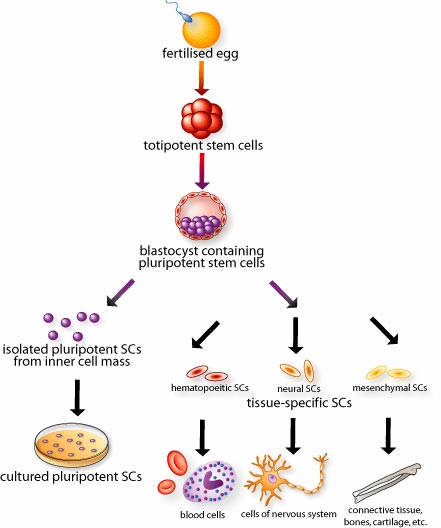LEARN ABOUT ORIGINAL CELL (Part 2)
Author: Dr. Tran Manh Hung , MA, STD
Original English
I. OVERVIEW OF ORIGINAL CELLS
Stem cells are one of the most fascinating areas of biology today. But like so many science areas that are growing, research on stem cells raises questions both scientifically and morally as soon as it reaches its first achievements.
What is stem cells and why are stem cells important?
Stem cells are the basal cells of all cells, tissues and organs in the body. Basically, every cell in the human body comes from a fertilized egg (also known as zygote) - the combination of sperm and eggs.

Fertilized egg: Fertilized eggs
Totipotent stem cells: 2
Blastocyst containing pluripotent stem cells: Embryo containing almighty stem cells 3
Isolated pluripotent SCs from inner cell mass: Almighty stem cells are separated from the internal cell mass
Hematopoeitic SCs: Blood stem cells
Neural SCs: Neural stem cells
Mesenchymal SCs: Mesenchymal stem cells
Tissue-specific SCs: Tissue-specific cells
Cultured pluripotent SCs: Almighty stem cells are cultured
Blood cells: Blood cells
Cells of nervous system: Neurons
Connective tissue: bones, cartilage, etc .: connective tissue : bone, cartilage .
But our bodies have more than 200 different types of cells, not just one. All of these types of cells come from a stem cell capital at the earliest stage of embryo development. During this period, as well as the later stages of development, different types of stem cells form specialized or differentiated cells that then perform specific functions in the human body; eg skin cells, blood cells, muscle cells and nerve cells.
Stem cells have an unparalleled ability, that is, they can develop into many other types of cells in the body. As a body repair system, they can theoretically be indefinitely divided to replace other cells, while at the same time ensuring the number of cells in the body, as long as human or animal alive. When a stem cell divides, each new cell has the ability to become a stem cell that can become another type of cell with specialized functions such as muscle cells, red blood cells or brain cells. .

Cell Differentiation - The process of cell differentiation
Skin cells of epidermis: Epidermal cells
Neuron of Brain: Neuron of Brain
Pigment Cell: Chromatophores
Ectoderm (External Layer): Exogenous ( outer layer)
Sperm: Sperm
Egg: Egg
Germ Cells: gametes
Zygote: Zygote
Blastocyst: Embryo
Gastrula: Praying
Mesoderm (Middle Layer): Middle cover (Middle layer)
Cardiac Muscle: Heart muscle
Skeletal Muscle Cells: Skeletal muscle cells
Tubule Cell of the Kidney: Tube cells in the kidney
Red Blood Cells: Red blood cells
Smooth Muscle (in Gut): Smooth muscle cells (in the intestine)
Endoderm (Internal Layer): Endoderm ( inner layer)
Lung Cell (Alveolar Cell): Lung cells (Lung pocket cells)
Thyroid Cell: Thyroid cell
Pancreatic Cell: Pancreatic cells
CELL AND DISEASE DISTRIBUTION PROCESS
All types of stem cells, regardless of where they come from, have three common characteristics: they have the ability to divide and replicate themselves for a long time; they are not differentiated; and they can develop into specialized cell types. Under proper conditions, stem cells can develop into specialized tissues and organs.
These unique properties are promising elements, making stem cells a source of cells, to treat diseases such as dementia, cancer, Parkinson's disease, type 1 diabetes, and seizures. Spinal injuries, stroke, burns, heart disease, chronic osteoarthritis and rheumatoid arthritis. Today, diseased, diseased tissues or organs are replaced by donors. Basically, the number of people needing transplants far exceeds the number of replacements available. Stem cells are a potential source of cells and tissues that can be used to treat many diseases, since stem cells can repair themselves and create specialized cells.
Because of this characteristic of stem cells, scientists are interested in research in search of medical treatments to replace damaged or damaged cells.
Note:
2 . Totipotent Stem Cells: Total stem cells. This type of cell grows after the egg is fertilized for 3-4 days, they are present in morula (morula). If the experts split one of these cells and implant the woman's uterus successfully. This total cell will develop into a fetus.
3 .Pluripotent Stem Cells: Almighty stem cells. They are only capable of developing into any cell in the body, including cells with specialized functions. However, they are not able to develop into one being as Totipotent Stem Cells.
Tra Mi translates
Complete translation of Tran Manh Hung
Copyright © 2008 byTrần Mạnh Hùng
- Part 1 - Part 3 - Part 4 - Part 5 - Part 6--
- LEARN ABOUT ORIGINAL CELL (Part 3)
- LEARN ABOUT ORIGINAL CELL (Part 1)
- LEARN ABOUT ORIGINAL CELL (Last part)
- LEARN ABOUT ORIGINAL CELL (Part 4)
- LEARN ABOUT ORIGINAL CELL (Part 5)
- Be careful about stem cell therapy
- Does the plant have sex?
- Things that many people may not know about the heart
- Ha Long Bay - Land wonders set in the sky
- Why don't you learn how to swim forever?
- Learn about different types of cancer
- Find the most difficult language to learn in the world
 Why do potatoes have eyes?
Why do potatoes have eyes? 'Tragedy' the world's largest carnivorous life: Death becomes ... public toilet
'Tragedy' the world's largest carnivorous life: Death becomes ... public toilet Tomatoes were once considered 'poisonous' for 200 years
Tomatoes were once considered 'poisonous' for 200 years Detecting microscopic parasites on human face
Detecting microscopic parasites on human face